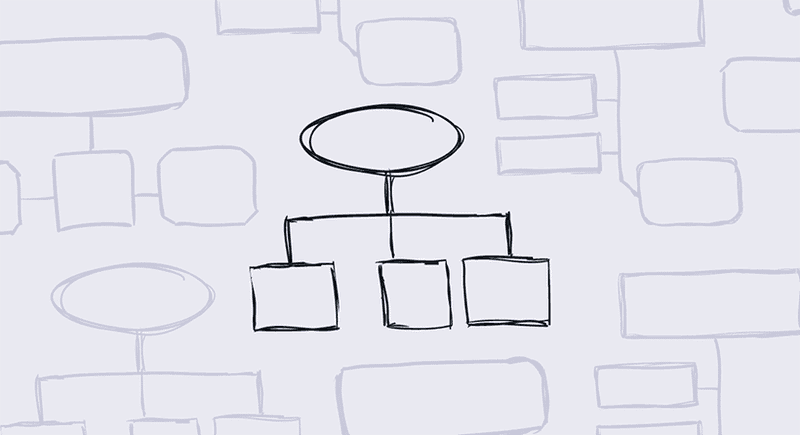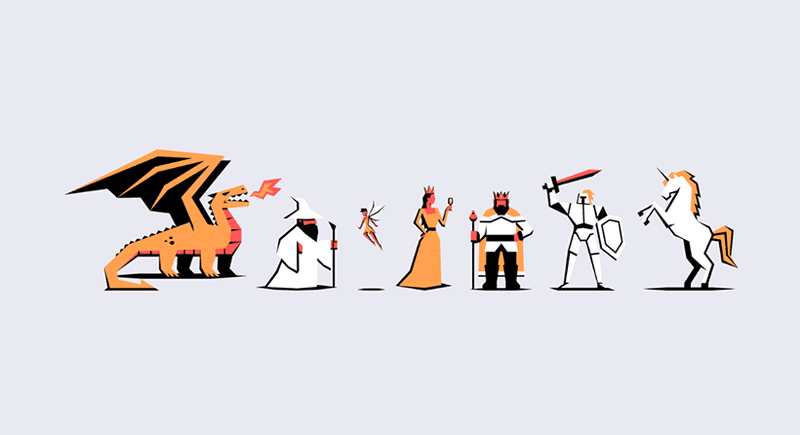It's just another normal day at the office for you as a designer. You arrive, greet your colleagues, and grab a coffee. On your way back, your boss asks you to participate in a brainstorming session to help solve a project problem. You promptly attend, of course.
When you arrive at the meeting room, you find a few more colleagues waiting. Your boss says, "Alright, let's start brainstorming. Give us your ideas."
However, this approach often leads to silence or few ideas, making the process inefficient. So why does this happen?
Brainstorming is one of the most well-known tools available, but there are techniques that can help unlock creativity and encourage participants to generate more ideas.
In this article, we will show you some of these techniques that can make the entire brainstorming process more productive!
Reading Tip: The Importance of Curiosity in UX Design
What is Brainstorming?
Brainstorming is a tool used to generate ideas and solutions for a previously identified problem.
Contrary to what some may think, brainstorming is not simply a meeting where people share their ideas without a clear objective.
In fact, brainstorming is a deliberate process that needs to be conducted in a way that is both effective and efficient. This can involve discussing an idea or finding a solution to a business problem.
To get the best results from the participants' creativity, this tool should be used with specific criteria and methods.
Although brainstorming is mainly used in creative processes, it can be utilized by any field, company, or market.
Brainstorming and UX Design

Brainstorming and UX Design have a close relationship.
This tool is widely used in other methods such as Design Thinking and Design Sprint. Since UX Design is all about finding and establishing the best user experiences, using brainstorming is pretty much a requirement.
Using this process, teams can generate ideas to solve customer problems, create products, or improve user experience.
It is important for designers to be familiar with this tool and its capabilities, as well as know how to lead a team through the process using these techniques.
Why Use Brainstorming?
In a scenario where ideas and solutions need to be generated, brainstorming provides a non-judgmental setting to explore the experiences of all participants.
This fusion of ideas contributes greatly to the development of solutions.
Brainstorming also fosters the involvement of everyone, including those who are more introverted, thereby extracting a wide range of ideas and perspectives.
The greater the diversity within the team, the more favorable the outcome of the process.
In addition, other advantages can be listed, such as:
- Improving collaboration and teamwork;
- Solving difficult problems;
- Expanding your portfolio of ideas and alternatives;
- Being in contact with different perspectives;
- Speed in problem-solving.
Reading Tip: Why Is Empathy Essential For UX Design?
How to use Brainstorming?
In general, the process of generating ideas is not complex and can be summarized in 3 major steps:
- Gather a group of people to discuss a problem;
- Guide people to create ideas, no matter how strange they may seem;
- Review the ideas, choose the most interesting ones, and work on them.
However, there are some "golden rules" that facilitate the process as a whole. They are:
- Establish a time limit according to the complexity of the problem to be solved;
- Communicate the objective and the problem that needs to be solved to all participants;
- Do not allow judgments or negative thoughts about other people's ideas;
- Focus on the quantity of ideas;
- Encourage ideas based on other ideas;
- Encourage ideas considered "ridiculous" or "crazy";
- Keep the process visual. Use boards, post-its, and stickers;
- Do not let participants lose focus.
Even with these rules, it is common to feel difficulty in generating ideas out of nowhere. In this sense, there are some types of brainstorming with more specific and different techniques that can help unlock some ideas.
Types of Brainstorming
The types of brainstorming bring different approaches to extract the maximum of ideas from the participants. Some of the most common types are:
- Analytical;
- Silent;
- Role Play;
- Creative.
Each of these types has different brainstorming techniques below them. Below we have more details about each one.
Analytical
Analytical brainstorming uses techniques that work with idea generation from people's analytical ability.
In general, we feel more comfortable when asked to analyze something than to have ideas. In this sense, some of the most used techniques in this type are:
1) Mind Mapping

Write your problem or challenge and ask participants to describe related issues and then more issues related to the previous ones.
Then, graphically put all the answers from this analysis, forming a model of a mind map.
The goal of this technique is to map similar situations and understand how they relate to creating or solving the problem.
This technique is so widely used that there are even apps that facilitate the visual construction of mind maps like Miro.
2) Reverse Brainstorming
As the name suggests, this technique seeks causes instead of solutions.
In a normal brainstorming process, we tend to identify solution ideas for a specific problem.
The proposal of the reverse process is to ask what is causing the problem.
Thus, with hypotheses formulated about the causes, it becomes easier to identify possible solutions to solve the problem.
3) Gap Filling

This technique consists of establishing a path between one point and another.
In this sense, describe the current situation and the situation up to where one wants to go. Then, ask participants to fill in this path with ideas that contribute to achieving the future situation.
The goal of this technique is to be able to list smaller tasks so that, when completed, the destination is reached.
4) SWOT Analysis
One of the most well-known techniques within companies. Its objective is to map what are the:
- Strengths;
- Weaknesses;
- Opportunities;
- Threats.
Usually, this technique is used to understand the feasibility of a project, whether it is a product or even a new company.
5) The Five Whys
Another well-known technique, it was developed by Sakichi Toyoda.
The technique involves establishing the problem and asking "Why?" five times in a row, or as many times as necessary, to identify the problem.
For example:
- The monthly goal was not met (problem);
- Why? (1)
- The product's revenue is low (problem);
- Why? (2)
- Because the app's conversion rate is low;
- Why? (3)
- Because users are not clicking the button;
- Why? (4)
- Because the button is not visible;
- Why? (5)
- Because we did not test with the users.
Usually, with 5 repetitions, it is possible to understand the cause of the problem. But the process can go deeper and deeper.
Reading Tip: Business Design: Why Is it Important to Know About Business?
6) Starbursting
This brainstorming technique is also based on asking questions to find solutions and ideas.
In this sense, when listing the problem, you ask questions based on the following words:
- who;
- what;
- where;
- when;
- why;
- how.
For example: Who are our users? Where do they buy the product? When do they use such a feature?
Thus, your team can generate discussions based on these questions.
Quiet Brainstorming
There are some cases where participants are physically distant, or have a lack of time in the schedule, and this makes it impossible to have a physical meeting to carry out the brainstorming process.
In these cases, a technique that can be used is Quiet Brainstorming.
With these techniques, it is possible to create ideas together without the need for physical presence. Some more common examples are:
1) Online Brainstorming

As the name suggests, this technique consists of using online programs that allow participants to generate ideas separately.
Then, the moderator puts all the ideas together and creates a discussion around them.
This way, even the most introverted person can participate calmly, as there is the possibility of anonymous participation.
2) Brainwriting
This brainstorming technique is used in teams whose participants have difficulty expressing their ideas to others.
In Brainwriting, participants write their ideas on paper, which are then randomly redistributed by the group.
This way, it is possible to discuss the ideas generated without people exposing themselves or feeling uncomfortable.
Reading Tip: Creating Responsive Design With Grids
3) Collaborative Brainwriting
Collaborative Brainwriting is an extension of regular Brainwriting.
In this version, the problem or question is written on a larger piece of paper. Then, this is placed in a common area of the company, where it can be seen by as many people as possible.
This way, different people, at different times, can leave their solution ideas on the established problem.
For this technique, it is important to remember to set a deadline for the ideas to be added to the paper.
Role Play Brainstorming

Another interesting type of brainstorming is Role Play.
This consists of playing roles to obtain insights and establish assumptions and hypotheses about your problem.
In this sense, for example, some people in the group can be assigned the role of users, others as suppliers, and others as stakeholders.
This way, using empathy, participants put themselves in the shoes of others to generate ideas and discussions.
Another way to use this technique, instead of defining roles, is to create discussions based on the question: What would someone else do in this situation?
With this, people are encouraged to think differently than they normally would.
Radically Creative
There are situations where the group seems unable to get out of the idea block, or there is a lack of more disruptive ideas.
When this happens, it is possible to use Radically Creative Brainstorming, which uses techniques that can help unlock the team's ideas.
1) Charrette
The charrette technique is usually used when the brainstorming process involves a large group.
In such cases, separate participants into small groups and break the problem into small questions, providing one per group.
Then, encourage the groups to create ideas about the proposed problem. Time for a few minutes and then switch the problems between the groups.
In this second round, the groups should build ideas based on the previous ones.
This way, the problems are discussed several times and the portfolio of ideas becomes more consistent.
2) "What if…"
The "What if…" brainstorming is another technique that helps unlock ideas and extrapolate the creative thinking of the team.
Faced with the problem, participants begin to create "What if…" questions to create new perspectives and ideas.
- What if this problem had happened 50 years ago?
- What if Batman could solve this problem?
The goal is really to overcome the limits of creativity, so there is no need for filters for the questions.
Reading Tip: Typography in UI: How To Enhance User Experience
Is individual brainstorming possible?

So far, we have seen different types of brainstorming that are usually used collaboratively, with more people.
However, is it possible to carry out the process individually?
Offering a short and direct answer, we will say yes. It is possible. But you have to be careful with which problem will be at the center of your ideation.
The efficiency of the individual process happens in the face of simpler problems. When there is a big challenge involved, it is best to use the tool collectively.
Also, working alone does not put you in contact with different experiences and points of view that often make a difference in designing a resolution.
Main precautions with the brainstorming process
Brainstorming is a very efficient tool for discussing problems and creating ideas and solutions.
However, it is important to know how to use it to get the most out of this tool.
Two main difficulties are:
- to get everyone's participation – including introverts -; and
- for participants to stay focused on the problem to be solved.
Therefore, it is important that there is always a moderator who facilitates the exercises and ensures that brainstorming can be truly productive.
Furthermore, do not limit brainstorming only to the Design process. You can use it in different situations and projects. It is a tool that can be used for any type of discussion and problem-solving.








